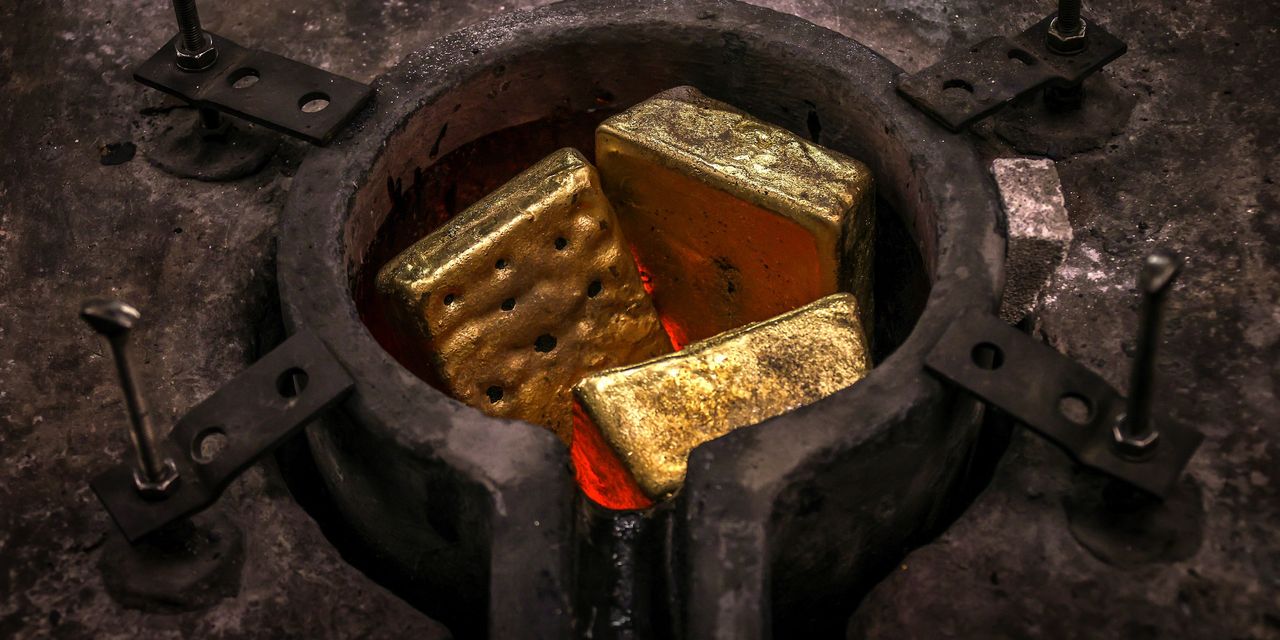Gold tumbles to under $1,800 an ounce after Fed ups inflation forecasts but signals higher interest rates
Gold futures were headed for their biggest one-day loss in months on Thursday, following a hawkish turn by the Federal Reserve.
For August delivery, gold
GCQ21,
GC00,
fell $72.20. or 3.9%, to $1,789.20 an ounce. On Wednesday, prices for the contract climbed $5, or 0.3%, to settle at $1,861.40 an ounce on Comex, and snapped a three-session losing streak, but prices began falling again shortly after the Fed announcement.
While the Federal Open Market Committee held its policy interest rate steady and made no change to its asset buying program on Wednesday, it also signaled an interest rate rise soon than expected, with its forecasts suggesting two increases in 2023. And the Fed lifted its inflation forecasts for this year and next.
Recent data showing surging prices had led many to believe the Fed would at least begin early discussions about reining in some of its ultra-accommodative policy aimed at cushioning the economy from the COVID-19 pandemic, but the policy statement was more hawkish than some expected.
Gold prices have been under pressure, losing more than 4% so far this week. On a continuous contract basis, Wednesday’s decline would mark the biggest one-day drop since Jan. 8, when prices fell 4%, according to FactSet. Gold is trading at levels not seen since early May.
The Fed’s hawkish turn sent bond yields surging, with that of the 2-year Treasury note
TMUBMUSD02Y,
hovering at the highest levels in a year at 0.201%. The ICE Dollar Index
DXY,
surged 0.7% to 91.77.
“Higher yields increase the opportunity cost of holding the non-interest-bearing gold, and prospects of a further rise in yields should cap the upside potential in the yellow metal despite the rising inflationary pressures,” said Ipek Ozkardeskaya, senior analyst at Swissquote, in a note to clients. She added that prices could drop below the key $1,800 an ounce level, which it did as the U.S. trading day began.
Investors should hardly be surprised about the prospects of a Fed interest rate increase in 2023, though the combination of a stronger U.S. dollar and rising yields do pose big hurdles for the precious metal, Carsten Fritsch, analyst at Commerzbank, told clients in a note.
“Whether it justifies a price slide on this scale is another matter, however. After all, gold had already fallen in recent days in anticipation of a possible change in direction on the part of the Fed. In our opinion, interest rate increases in two years’ time are too far off to warrant any such slump in price, especially as yields are well below the expected rate of inflation,” said Fritsch.
And he noted that Fed Chair Jerome Powell said the possibility of exiting bond purchasing was discussed but no decision was taken, so the central bank will continue to buy bonds amounting to $120 billion each month, further boosting its balance sheet and money supply.
“We view the pronounced slide in the gold price as excessive, though it is likely to take some time before the setback has been digested,” said Fritsch.
Also falling was July silver
SIN21,
which slid 93 cents, or 3.3%, to settle at $26.87 an ounce. That drop takes silver to a level not seen since early May.
Opinion: What lumber and gold prices tell us about the stock market’s next move
Elsewhere, prices of other metals were also lower, as July copper
HGN21,
fell 1.9% to nearly $4.30 a pound on Wednesday, in a week that has so far seen the metal drop more than 5%.
July platinum
PLN21,
slid $35.70, or 3%, to $1,106.10 an ounce, while September palladium
PAU21,
tumbled $93.30, or 3.3%, to $2,743.50 an ounce.
On Wednesday, China’s National Food and Strategic Reserves Administration said it planned to release copper, aluminum, zinc and other national reserves in batches in the near future, to ensure the supply and price stability of bulk commodities.
[ad_2]
Source

